trailer TOYOTA CAMRY 2021 Owners Manual (in English)
[x] Cancel search | Manufacturer: TOYOTA, Model Year: 2021, Model line: CAMRY, Model: TOYOTA CAMRY 2021Pages: 660, PDF Size: 16.97 MB
Page 3 of 660

3
1
8 7 5 4
3
2
CAMRY_U
9
6
3-1. Key informationKeys .................................. 138
3-2. Opening, closing and locking the doors
Doors................................. 147
Trunk ................................. 156
Smart key system.............. 161
3-3. Adjusting the seats Front seats ........................ 169
Rear seats ......................... 171
Head restraints .................. 173
3-4. Adjusting the steering wheel and mirrors
Steering wheel .................. 175
Inside rear view mirror....... 177
Outside rear view mirrors ............................. 179
3-5. Opening and closing the windows
Power windows ................. 181
Moon roof .......................... 185
Panoramic moon roof ........ 189 4-1. Before driving
Driving the vehicle ............. 196
Cargo and luggage ............ 205
Vehicle load limits .............. 208
Trailer towing ..................... 209
Dinghy towing .................... 210
4-2. Driving procedures Engine (ignition) switch (vehicles without a
smart key system) ........... 211
Engine (ignition) switch (vehicles with a
smart key system) ........... 213
Automatic transmission ..... 219
Turn signal lever ................ 225
Parking brake .................... 226
Electric parking brake ........ 227
Brake Hold ......................... 231
4-3. Operating the lights and wipers
Headlight switch ................ 233
AHB (Automatic High Beam) .............................. 238
Windshield wipers and washer ............................. 242
4-4. Refueling Opening the fuel tank cap................................... 246
3Operation of each
component4Driving
Page 195 of 660

195
4Driving
CAMRY_U4-1. Before driving
Driving the vehicle ............. 196
Cargo and luggage ........... 205
Vehicle load limits ............. 208
Trailer towing..................... 209
Dinghy towing ................... 210
4-2. Driving procedures Engine (ignition) switch (vehicles without a
smart key system) ........... 211
Engine (ignition) switch (vehicles with a
smart key system) ........... 213
Automatic transmission ..... 219
Turn signal lever................ 225
Parking brake .................... 226
Electric parking brake........ 227
Brake Hold ........................ 231
4-3. Operating the lights and wipers
Headlight switch ................ 233
AHB (Automatic High Beam) ............................. 238
Windshield wipers and washer ............................ 242
4-4. Refueling Opening the fuel tank cap .................................. 246 4-5. Using the driving
support systems
Toyota Safety Sense 2.5+ ................................. 250
PCS (Pre-Collision System)........................... 258
LTA (Lane Tracing Assist) ............................. 274
RSA (Road Sign Assist) .... 289
Dynamic radar cruise control with full-speed
range............................... 294
Dynamic radar cruise control ............................. 310
Driving assist systems ...... 326
BSM (Blind Spot Monitor)........................... 334
• BSM function ................ 339
Intuitive parking assist....... 342
RCTA (Rear Cross Traffic Alert) ............................... 350
• RCTA function .............. 352
Rear Camera Detection Function .......................... 357
PKSB (Parking Support Brake) ............................. 361
Parking Support Brake function
(static objects)................. 368
Parking Support Brake function (rear-crossing
vehicles).......................... 377
Driving mode select switches .......................... 384
4-6. Driving tips Winter driving tips ............. 386
Page 205 of 660
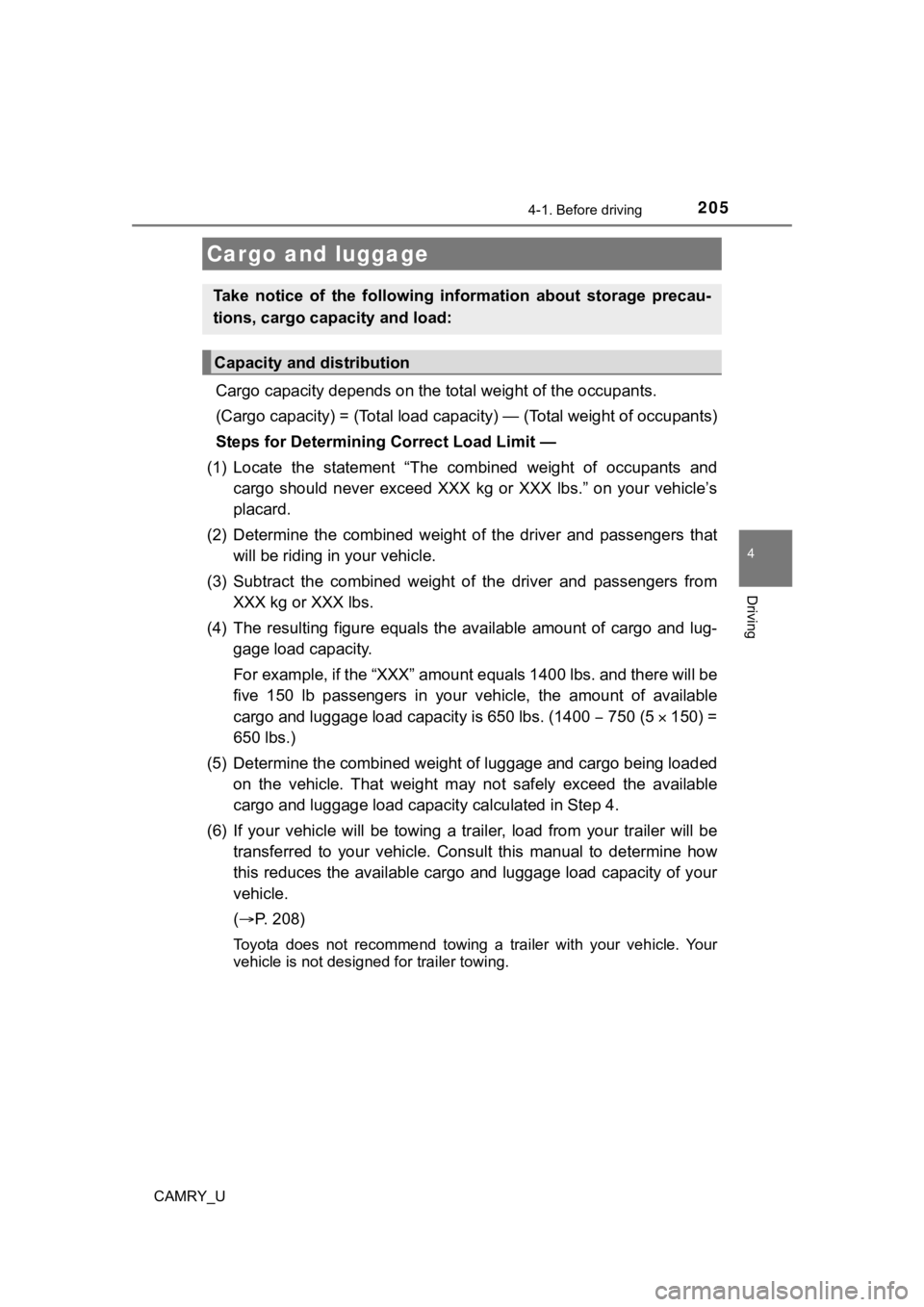
2054-1. Before driving
4
Driving
CAMRY_U
Cargo capacity depends on the total weight of the occupants.
(Cargo capacity) = (Total load capacity) — (Total weight of occ upants)
Steps for Determining Correct Load Limit —
(1) Locate the statement “The co mbined weight of occupants and
cargo should never exceed XXX kg or XXX lbs.” on your vehicle’s
placard.
(2) Determine the combined weight of the driver and passengers t hat
will be riding in your vehicle.
(3) Subtract the combined weight of the driver and passengers fr om
XXX kg or XXX lbs.
(4) The resulting figure equals the available amount of cargo an d lug-
gage load capacity.
For example, if the “XXX” amount equals 1400 lbs. and there wil l be
five 150 lb passengers in your vehicle, the amount of available
cargo and luggage load capacity is 650 lbs. (1400 750 (5150) =
650 lbs.)
(5) Determine the combined weight of luggage and cargo being loa ded
on the vehicle. That weight may n ot safely exceed the available
cargo and luggage load capac ity calculated in Step 4.
(6) If your vehicle will be towing a trailer, load from your tra iler will be
transferred to your vehicle. Consult this manual to determine h ow
this reduces the available cargo and luggage load capacity of y our
vehicle.
( P. 208)
Toyota does not recommend towing a trailer with your vehicle. Y our
vehicle is not desig ned for trailer towing.
Cargo and luggage
Take notice of the following information about storage precau-
tions, cargo capacity and load:
Capacity and distribution
Page 208 of 660
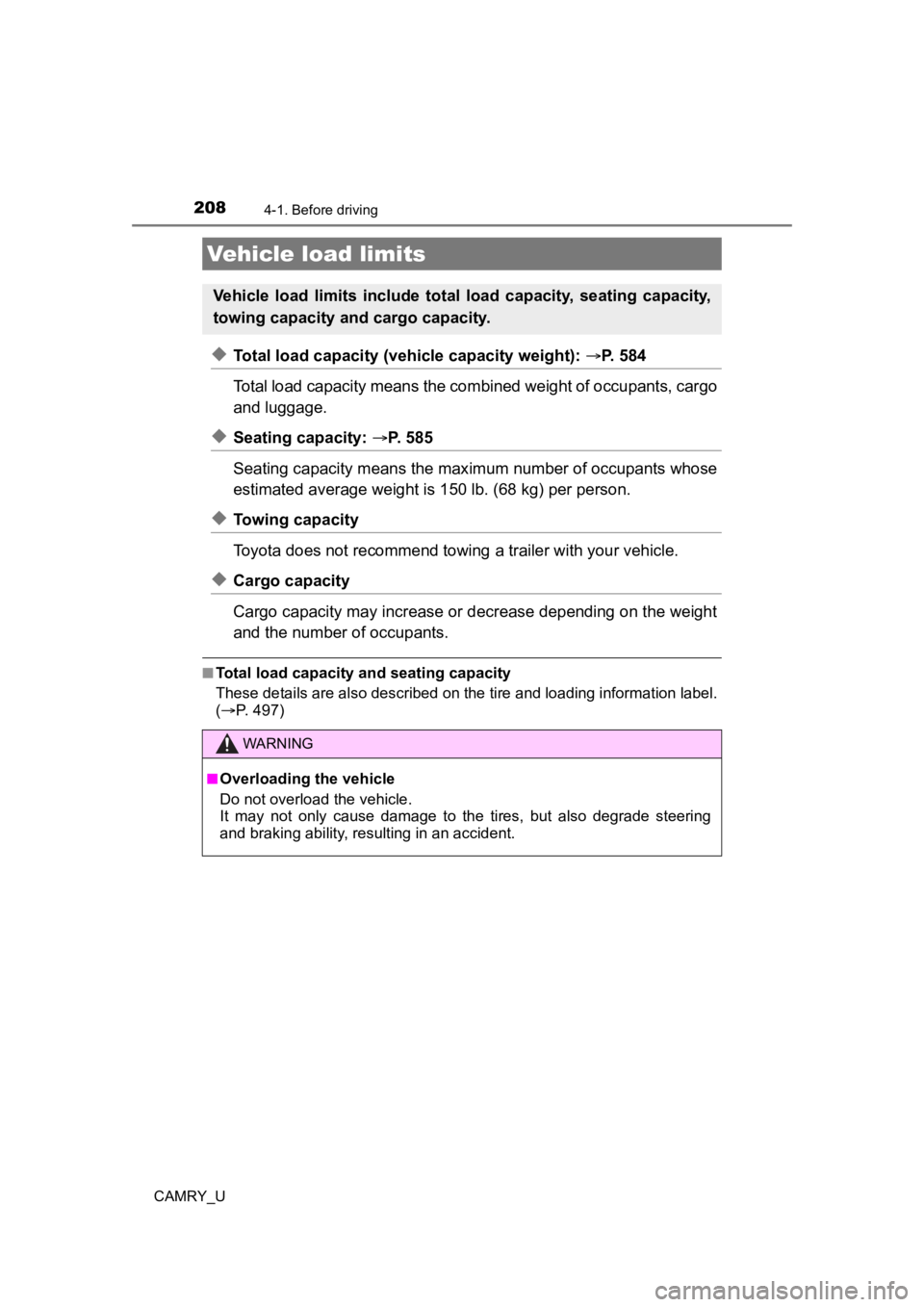
2084-1. Before driving
CAMRY_U
◆Total load capacity (vehicle capacity weight): P. 584
Total load capacity means the co mbined weight of occupants, cargo
and luggage.
◆Seating capacity: P. 5 8 5
Seating capacity means the max imum number of occupants whose
estimated average weight is 150 lb. (68 kg) per person.
◆Towing capacity
Toyota does not recommend towing a trailer with your vehicle.
◆Cargo capacity
Cargo capacity may increase or decrease depending on the weight
and the number of occupants.
■Total load capacity and seating capacity
These details are also described on the tire and loading inform ation label.
( P. 497)
Vehicle load limits
Vehicle load limits include total load capacity, seating capaci t y,
towing capacity and cargo capacity.
WARNING
■Overloading the vehicle
Do not overload the vehicle.
It may not only cause damage to the tires, but also degrade steering
and braking ability, resulting in an accident.
Page 209 of 660
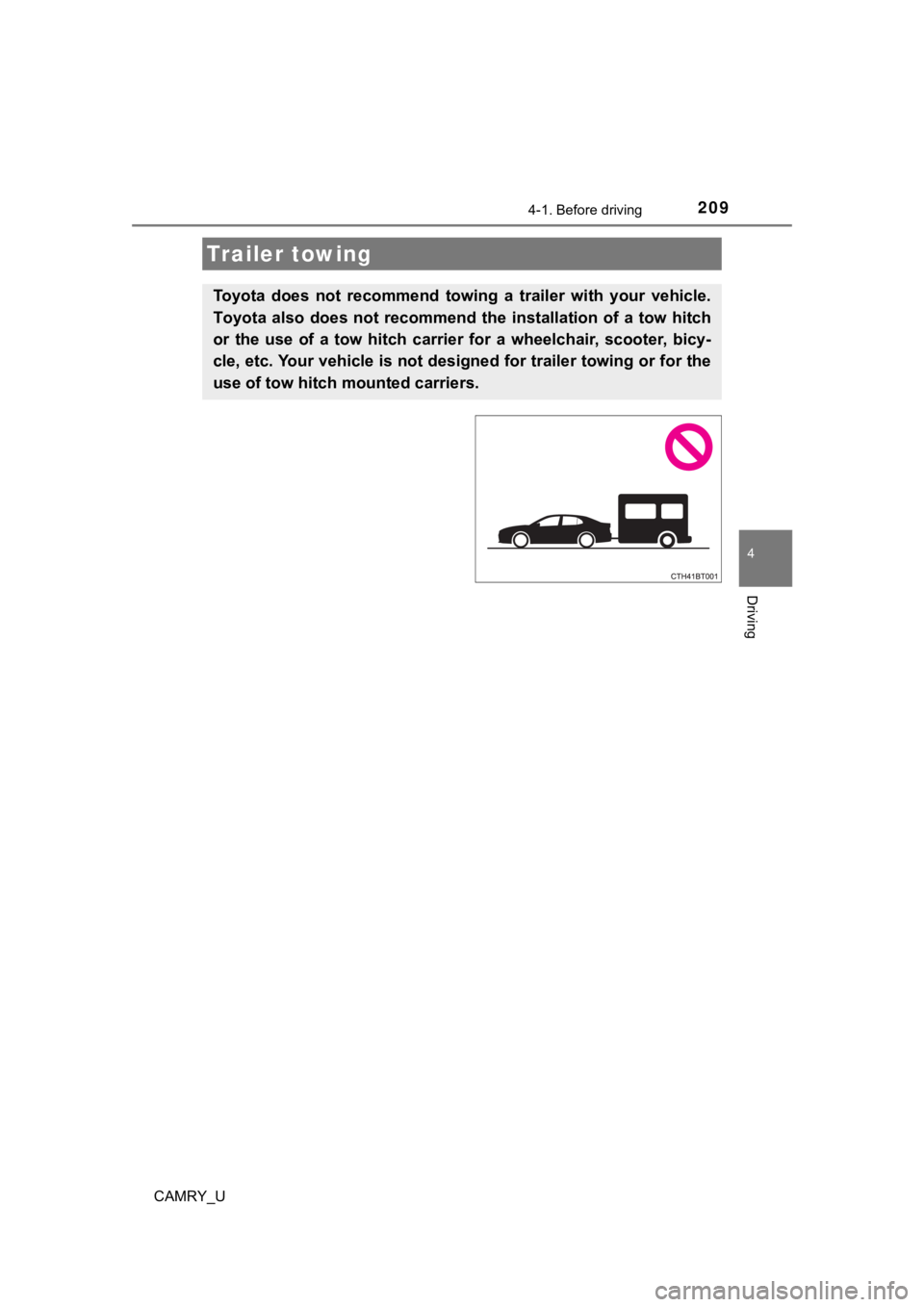
2094-1. Before driving
4
Driving
CAMRY_U
Trailer towing
Toyota does not recommend towing a trailer with your vehicle.
Toyota also does not recommend the installation of a tow hitch
or the use of a tow hitch carrier for a wheelchair, scooter, bi cy-
cle, etc. Your vehicle is not des igned for trailer towing or for the
use of tow hitch mounted carriers.
Page 241 of 660

2414-3. Operating the lights and wipers
4
Driving
CAMRY_U●
In the following situations the system may not be able to correctly detect the
surrounding brightness level. This may cause the low beams to r emain on
or the high beams to flash or dazzle pedestrians or vehicles ah ead. In such
a case, it is necessary to manually switch between the high and low beams.
• When driving in inclement weather (heavy rain, snow, fog, sand storms,
etc.)
• When the windshield is obscured by fog, mist, ice, dirt, etc.
• When the windshield is cracked or damaged
• When the front camera is deformed or dirty
• When the temperature of the front camera is extremely high
• When the surrounding brightness level is equal to that of head lights, tail
lights or fog lights
• When headlights or tail lights of vehicles ahead are turned off, dirty,
changing color, or not aimed properly
• When the vehicle is hit by water, snow, dust, etc. from a prec eding vehi-
cle
• When driving through an area of intermittently changing brightness and darkness
• When frequently and repeatedly driving ascending/descending roads, or
roads with rough, bumpy or uneven surfaces (such as stone-paved
roads, gravel roads, etc.)
• When frequently and repeatedly taking curves or driving on a w inding
road
• When there is a highly reflective object ahead of the vehicle, such as a sign or mirror
• When the back of a preceding vehicle is highly reflective, suc h as a con-
tainer on a truck
• When the vehicle's headlights are damaged or dirty, or are not aimed
properly
• When the vehicle is listing or titling due to a flat tire, a trailer being towed,
etc.
• When the headlights are changed between the high beams and low beams repeatedly in an abnormal manner
• When the driver believes that the high beams may be flashing or dazzling pedestrians or other drivers
■ Temporarily lowering sensor sensitivity
The sensitivity of the sensor can be temporarily lowered.
Turn the engine switch off while the following conditions are m et.
• The headlight switch is in the or position.
• The headlight switch lever is in the original position.
Turn the engine switch to the “ON” position (vehicles without a smart key
system) or IGNITION ON mode (vehicles with a smart key system).
Within 60 seconds after , repeat pushing the headlight switch lever to the
high beam position then pulling it to the original position qui ckly 10 times,
then leave the lever in the original position.
1
2
32
Page 271 of 660
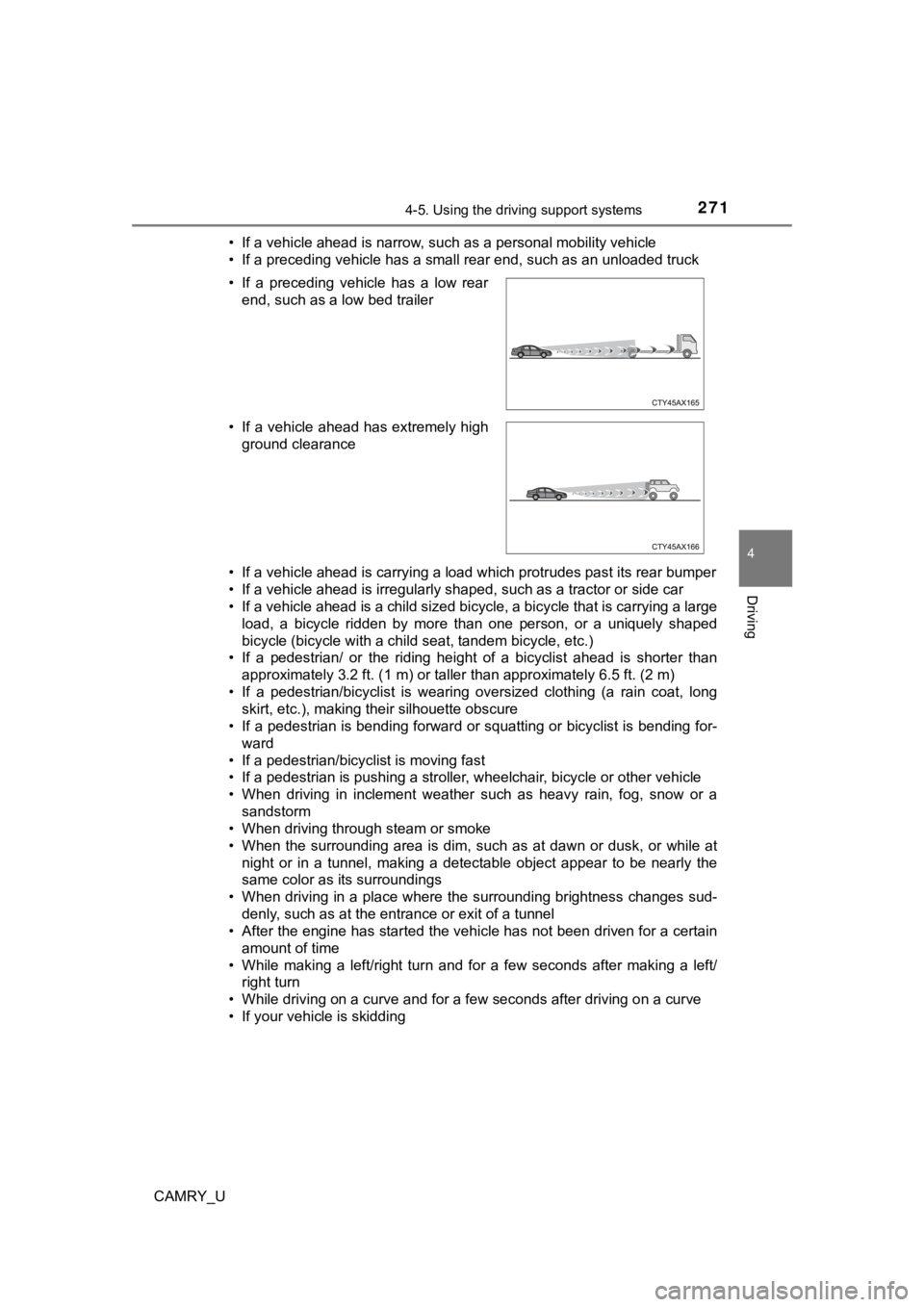
2714-5. Using the driving support systems
4
Driving
CAMRY_U• If a vehicle ahead is narrow, such as a personal mobility vehi
cle
• If a preceding vehicle has a small rear end, such as an unload ed truck
• If a vehicle ahead is carrying a load which protrudes past its rear bumper
• If a vehicle ahead is irregularly shaped, such as a tractor or side car
• If a vehicle ahead is a child sized bicycle, a bicycle that is carrying a large
load, a bicycle ridden by more than one person, or a uniquely shaped
bicycle (bicycle with a child seat, tandem bicycle, etc.)
• If a pedestrian/ or the riding height of a bicyclist ahead is shorter than
approximately 3.2 ft. (1 m) or taller than approximately 6.5 ft. (2 m)
• If a pedestrian/bicyclist is wearing oversized clothing (a rai n coat, long
skirt, etc.), making their silhouette obscure
• If a pedestrian is bending forward or squatting or bicyclist i s bending for-
ward
• If a pedestrian/bicyclist is moving fast
• If a pedestrian is pushing a stroller, wheelchair, bicycle or other vehicle
• When driving in inclement weather such as heavy rain, fog, snow or a
sandstorm
• When driving through steam or smoke
• When the surrounding area is dim, such as at dawn or dusk, or while at
night or in a tunnel, making a detectable object appear to be n early the
same color as its surroundings
• When driving in a place where the surrounding brightness changes sud-
denly, such as at the entrance or exit of a tunnel
• After the engine has started the vehicle has not been driven for a certain amount of time
• While making a left/right turn and for a few seconds after mak ing a left/
right turn
• While driving on a curve and for a few seconds after driving o n a curve
• If your vehicle is skidding • If a preceding vehicle has a low rear end, such as a low bed trailer
• If a vehicle ahead has extremely high ground clearance
Page 308 of 660
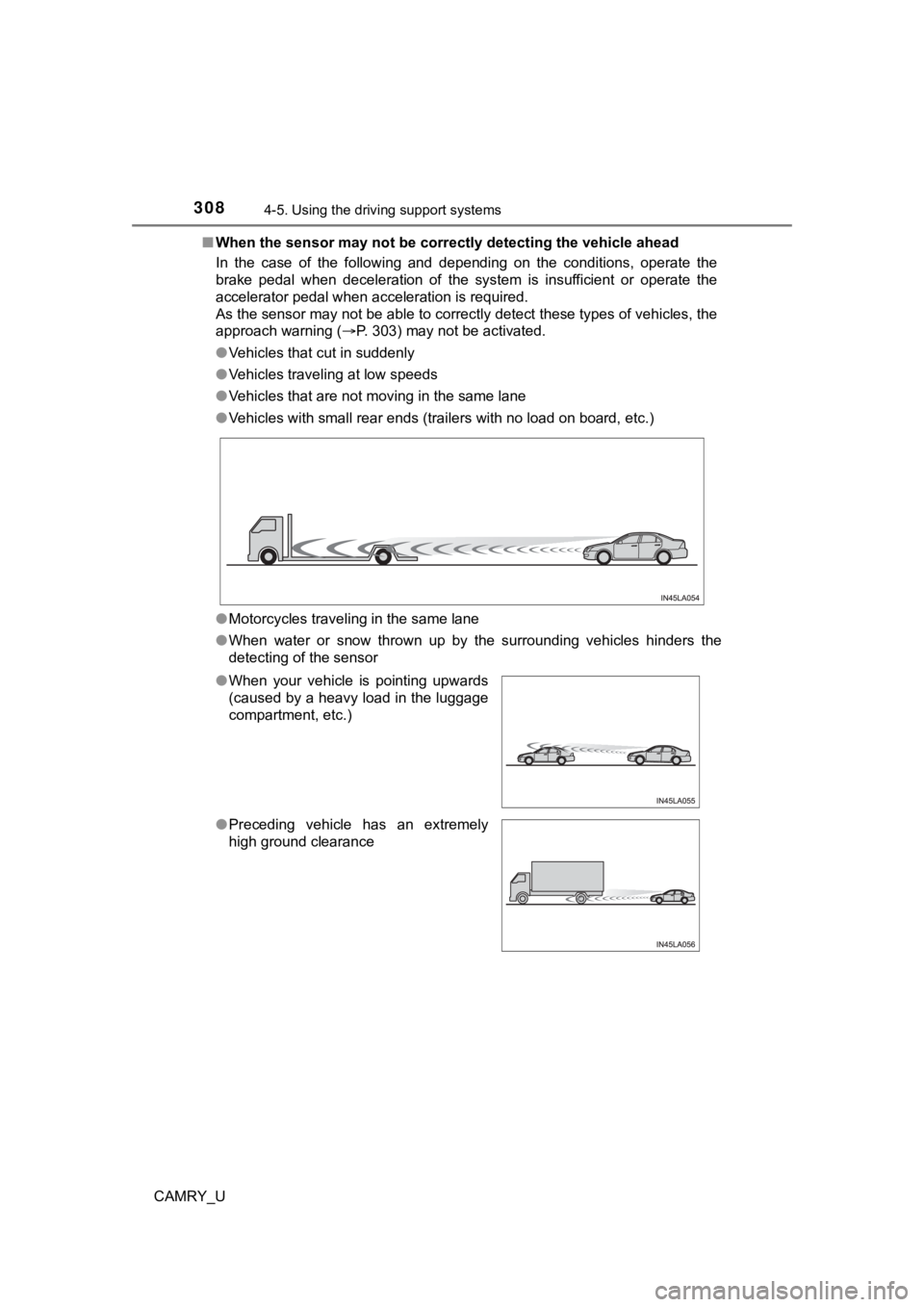
3084-5. Using the driving support systems
CAMRY_U■
When the sensor may not be correctly detect ing the vehicle ahead
In the case of the following and depending on the conditions, o perate the
brake pedal when deceleration of the system is insufficient or operate the
accelerator pedal when acceleration is required.
As the sensor may not be able to correctly detect these types o f vehicles, the
approach warning ( P. 303) may not be activated.
● Vehicles that cut in suddenly
● Vehicles traveling at low speeds
● Vehicles that are not moving in the same lane
● Vehicles with small rear ends (trailers with no load on board, etc.)
● Motorcycles traveling in the same lane
● When water or snow thrown up by the surrounding vehicles hinders the
detecting of the sensor
●When your vehicle is pointing upwards
(caused by a heavy load in the luggage
compartment, etc.)
● Preceding vehicle has an extremely
high ground clearance
Page 324 of 660
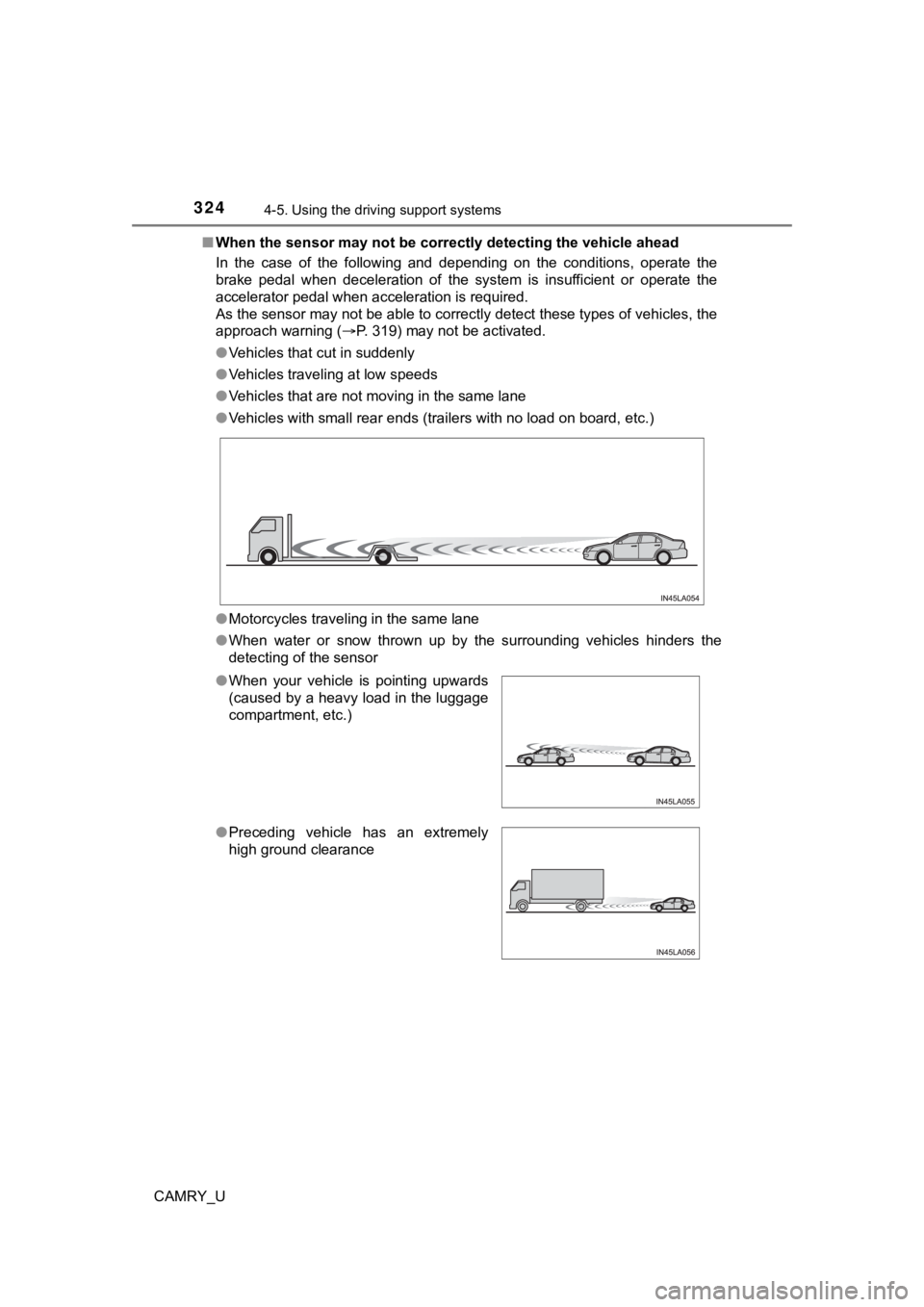
3244-5. Using the driving support systems
CAMRY_U■
When the sensor may not be correctly detect ing the vehicle ahead
In the case of the following and depending on the conditions, o perate the
brake pedal when deceleration of the system is insufficient or operate the
accelerator pedal when acceleration is required.
As the sensor may not be able to correctly detect these types o f vehicles, the
approach warning ( P. 319) may not be activated.
● Vehicles that cut in suddenly
● Vehicles traveling at low speeds
● Vehicles that are not moving in the same lane
● Vehicles with small rear ends (trailers with no load on board, etc.)
● Motorcycles traveling in the same lane
● When water or snow thrown up by the surrounding vehicles hinders the
detecting of the sensor
●When your vehicle is pointing upwards
(caused by a heavy load in the luggage
compartment, etc.)
●Preceding vehicle has an extremely
high ground clearance
Page 657 of 660

657Alphabetical index
CAMRY_U
Seat heater switches ............ 412
“SOS” button ........................... 73
Talk switch
*
Trunk opener switch ............. 156
Vehicle-to-vehicle distance button ........... 294, 310
VSC OFF switch ................... 328
Window lock switch............... 181
Windshield wiper and washer switch ..................... 242
Tachometer ................................ 92
Tail lights Light switch ........................... 233
Replacing light bulbs............. 522
Talk switch
*
Theft deterrent system
Alarm ...................................... 82
Engine immobilizer system ..... 79
Tire inflation pressure ............. 497 Maintenance data ................. 594
Warning light ......................... 541
Tire information ....................... 603 Glossary................................ 610
Size ....................................... 606
Tire identification number ..... 605
Uniform Tire Quality Grading............................... 608 Tire pressure warning system
Initializing .............................. 484
Installing tire pressure
warning valve and
transmitters ........................ 484
Registering ID codes ............ 486
Warning light......................... 541
Tires .......................................... 482
Chains .................................. 387
Checking............................... 482
Glossary ............................... 610
If you have a flat tire ............. 553
Inflation pressure .................. 594
Replacing.............................. 553
Rotating tires ........................ 482
Size....................................... 594
Snow tires ............................. 388
Spare tire .............................. 553
Tire pressure warning system .......... ...................... 483
Uniform Tire Quality Grading .............................. 608
Warning light......................... 541
Tools ......................................... 554
Top tether strap ......................... 70
Total load capacity .................. 208
Towing Dinghy towing ....................... 210
Emergency towing ................ 530
Trailer towing ........................ 209
T
*: Refer to the “NAVIGATION AND MULTIMEDIA SYSTEM OWNER’S MANUAL”.